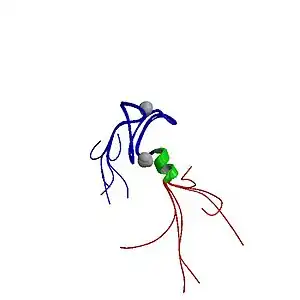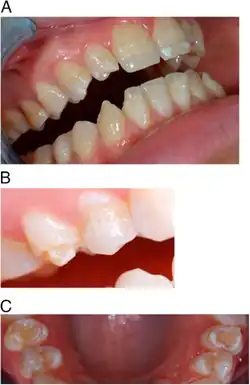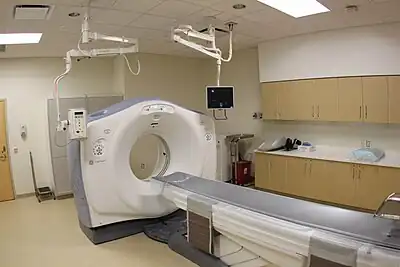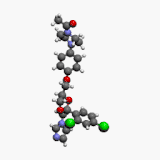Autoimmune polyendocrine syndrome
| Autoimmune polyendocrine syndrome | |
|---|---|
| Other names: Autoimmune polyglandular syndromes (APSs) | |
 | |
| The autoimmune regulator protein (from the AIRE gene, which causes autoimmune polyendocrine syndrome type 1 when non-functional) | |
| Types | APS type1, APS type 2, IPEX syndrome |
| Causes | FOXP3 gene is involved in the mechanism [1] |
| Diagnostic method | Endoscopic, CT scan[2] |
| Treatment | Depends on type |
Autoimmune polyendocrine syndromes (APSs), also called polyglandular autoimmune syndromes (PGASs)[3] or polyendocrine autoimmune syndromes (PASs), are a heterogeneous group[4] of rare diseases characterized by autoimmune activity against more than one endocrine organ, although non-endocrine organs can be affected. There are three types of APS, and there are a number of other diseases which involve endocrine autoimmunity.[2][5][6]
Types

- Autoimmune polyendocrine syndrome type 1,[2] an autosomal recessive syndrome due to mutation of the AIRE gene resulting in hypoparathyroidism, adrenal insufficiency, hypogonadism, vitiligo, candidiasis and others.
- Autoimmune polyendocrine syndrome type 2,[7] an autosomal dominant syndrome due to multifactorial gene involvement resulting in adrenal insufficiency plus hypothyroidism and/or type 1 diabetes.
- Immunodysregulation polyendocrinopathy enteropathy X-linked syndrome (IPEX syndrome) is X-linked recessive due to mutation of the FOXP3 gene on the X chromosome. Most develop diabetes and diarrhea and many die due to autoimmune activity against many organs. Boys are affected, while girls are carriers and might suffer mild disease.[2][8][9][10]
Cause
Each "type" of this condition has a different genetic cause. IPEX syndrome is inherited in males by an X-linked recessive process. The FOXP3 gene, whose cytogenetic location is Xp11.23, is involved in the mechanism of the IPEX condition.[11][1]
Diagnosis
Diagnosis for type 1 of this condition for example, sees that the following methods/tests are available:[2]
- Endoscopic
- CT scan
- Histologic test
Differential diagnosis
For this condition, differential diagnosis sees that the following should be considered:[12]
- CD25 deficiency
- STAT5B deficiency
- Severe combined immunodeficiency
- X linked thrombocytopenia
Management
Immunosuppressive therapy may be used in type I of this condition.[13] Ketoconazole can also be used for type I under certain conditions.[2]
The component diseases are managed as usual; the challenge is to detect the possibility of any of the syndromes and to anticipate other manifestations. For example, in a person with known type 2 autoimmune polyendocrine syndrome but no features of Addison's disease, regular screening for antibodies against 21-hydroxylase may prompt early intervention and hydrocortisone replacement to prevent characteristic crises
See also
References
- 1 2 Reference, Genetics Home. "FOXP3 gene". Genetics Home Reference. Archived from the original on 2017-04-17. Retrieved 2017-05-11.
- 1 2 3 4 5 6 "Type I Polyglandular Autoimmune Syndrome: Background, Pathophysiology, Epidemiology". 2017-01-06. Archived from the original on 2018-04-05. Retrieved 2021-05-23.
{{cite journal}}: Cite journal requires|journal=(help) - ↑ Dittmar, Manuela; Kahaly, George J. (2003). "Polyglandular Autoimmune Syndromes: Immunogenetics and Long-Term Follow-Up". The Journal of Clinical Endocrinology & Metabolism. 88 (7): 2983–2992. doi:10.1210/jc.2002-021845. PMID 12843130. Archived from the original on 13 March 2013. Retrieved 1 July 2013.
- ↑ Eisenbarth GS, Gottlieb PA (2004). "Autoimmune polyendocrine syndromes". N. Engl. J. Med. 350 (20): 2068–79. doi:10.1056/NEJMra030158. PMID 15141045.
- ↑ "Type III Polyglandular Autoimmune Syndrome: Background, Pathophysiology, Epidemiology". 2017-05-03. Archived from the original on 2021-05-10. Retrieved 2021-05-23.
{{cite journal}}: Cite journal requires|journal=(help) - ↑ "Type II Polyglandular Autoimmune Syndrome: Background, Pathophysiology, Epidemiology". 2017-05-03. Archived from the original on 2021-05-11. Retrieved 2021-05-23.
{{cite journal}}: Cite journal requires|journal=(help) - ↑ "Autoimmune polyglandular syndrome type 2 | Genetic and Rare Diseases Information Center (GARD) – an NCATS Program". rarediseases.info.nih.gov. Archived from the original on 2017-04-13. Retrieved 2017-04-20.
- ↑ "IPEX syndrome". Genetics Home Reference. Archived from the original on 2017-04-17. Retrieved 2017-04-20.
- ↑ "Immunodysregulation, polyendocrinopathy and enteropathy X-linked | Genetic and Rare Diseases Information Center (GARD) – an NCATS Program". rarediseases.info.nih.gov. Archived from the original on 2019-01-09. Retrieved 2017-04-20.
- ↑ Wildin, R. S.; Smyk-Pearson, S.; Filipovich, A. H. (1 August 2002). "Clinical and molecular features of the immunodysregulation, polyendocrinopathy, enteropathy, X linked (IPEX) syndrome". Journal of Medical Genetics. 39 (8): 537–545. doi:10.1136/jmg.39.8.537. ISSN 0022-2593. PMC 1735203. PMID 12161590.
- ↑ Reference, Genetics Home. "IPEX syndrome". Genetics Home Reference. Archived from the original on 2017-04-17. Retrieved 2017-05-11.
- ↑ RESERVED, INSERM US14 -- ALL RIGHTS. "Orphanet: Immune dysregulation polyendocrinopathy enteropathy X linked syndrome". www.orpha.net. Archived from the original on 2017-04-19. Retrieved 2017-05-11.
- ↑ Weiler, Fernanda Guimarães; Dias-da-Silva, Magnus R.; Lazaretti-Castro, Marise (2012-02-01). "Autoimmune polyendocrine syndrome type 1: case report and review of literature". Arquivos Brasileiros de Endocrinologia & Metabologia. 56 (1): 54–66. doi:10.1590/S0004-27302012000100009. ISSN 0004-2730. PMID 22460196.
Further reading
- Improda, Nicola; Capalbo, Donatella; Cirillo, Emilia; Cerbone, Manuela; Esposito, Andrea; Pignata, Claudio; Salerno, Mariacarolina (1 November 2014). "Cutaneous vasculitis in patients with autoimmune polyendocrine syndrome type 1: report of a case and brief review of the literature". BMC Pediatrics. 14: 272. doi:10.1186/1471-2431-14-272. ISSN 1471-2431. PMC 4286916. PMID 25361846.
- Shoenfeld, Yehuda; Cervera, Ricard; Gershwin, M. Eric (2008). Diagnostic Criteria in Autoimmune Diseases. Springer Science & Business Media. ISBN 9781603272858. Archived from the original on 2021-04-25. Retrieved 2021-05-23.
External links
- Diseases Database (DDB): 29690
- PubMed Archived 2020-02-10 at the Wayback Machine
| Classification | |
|---|---|
| External resources |

